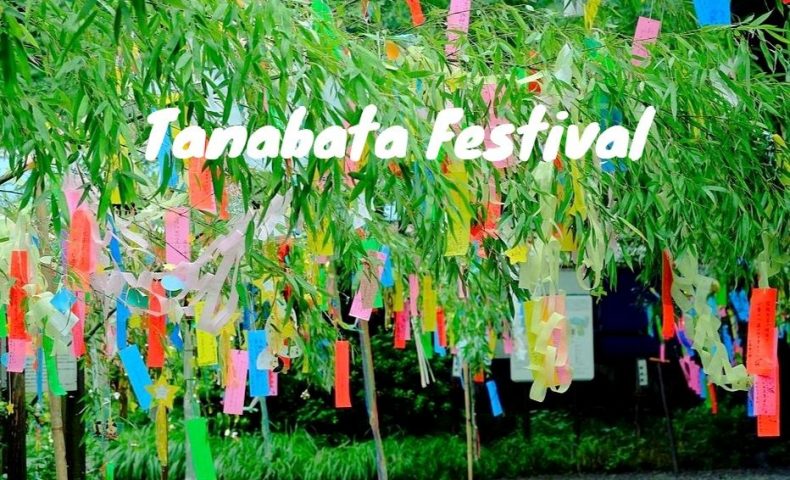Tanabata festival decorations
One of the best parts about living in Japan has to be the festivals. Nothing screams “party!” more than thousands of colorful items decorating the city, floats with giant mythical creatures, and hundreds of people dancing in the streets.
Festivals are a great reason to get out of the apartment and travel the country. Cities across the country hold different festivals and celebrate the same festivals differently. Festivals are such a big part of Japanese culture that even Disney celebrates the Japanese festivals, having their mascots dressed in traditional clothes and greeting theme-park-goers.
In this entry of the Festivals and Holidays series we will take a look at the colorful festival of the stars, Tanabata or “Seven Stars”.
Tanabata (七夕, tanabata) traces its origin to China with the Qixi (also written “seven stars” in Chinese) Festival. The story goes that long ago the seamstress Princess Orihime, symbolized by the star Vega, wove beautiful garments and tapestries by the heavenly river, the Milky Way. Orihime worked so hard weaving that she became depressed and began to worry that she will never find love.
Her father saw her despair and arranged for her to meet a cow herder Hikoboshi, symbolized by the star Altair, who lived on the other side of the Milky Way. The two fell madly in love. They were so in love that Orihime stopped weaving and Hikoboshi allowed his cows to wander.
The king, Orihime’s father, saw how they were neglecting their duties and forbade the lovers to see each other again. Orihime pleaded with him to allow them to stay together, so the king compromised and decreed: as long as you do not neglect your duties you may meet once a year, on the seventh day of the seventh month.
The story of the two star-crossed lovers meeting on the seventh day of the seventh month leads to the festival begin held on different days depending on region. In Tokyo, Tanabata is celebrated in accordance to the western calendar: July 7th. The Sendai Tanabata festival, the most well known Tanabata festival, which dates back over 400 years, is held in August from the 6th through the 8th.
The reason for the Tanabata festivals being held in August is due to celebrating following the lunar-solar calendar. The lunar-solar calendar was used in Japan up until the Meiji Restoration period, circa 1868.

Fukinagashi hung in a busy shopping area
Compared to many other Japanese festivals, Tanabata is a reserved celebration. By that I mean there are no huge floats (Aomori Nebuta Festival) or mobs of people hoisting sacred objects through the streets (mikoshi parades).
Instead, Tanabata is celebrated with extravagant and colorful decorations, much like what Orihime would weave in the story. Places celebrating Tanabata will clad their heavily trafficked places, like shopping centers and malls, with brightly colored streamers and various other ornaments.
The most synonymous decoration with Tanabata is fukinagashi (吹流し, fukinagashi), which is a large bright streamer. The fukinagashi are usually hung from the rafters as they are incredibly large, eclipsing a normal person.
Since everyone cannot hang these massive fukinagashi in their apartments, many looking to get into the festivities will decorate bamboo trees with tanzaku (短冊, tanzaku). Tanzaku are small colored pieces of parchment on which people inscribe their wishes, hopes, and dreams so that one day they may come true. They then hang the tanzaku papers on bamboo trees in places that celebrate Tanabata.
This is a excellent activity for kids and adults alike and seeing the various colored tanzaku adorning bamboo trees makes for a fun atmosphere and photo opportunity. In some places, when the Tanabata celebration is over, the tanzaku are floated on rivers and/or burned; this is believed to be the two ways to deliver the messages to the deities.

Hanging tanzaku
Tanabata is a festival of colors, decorations, and the summer season. The celebration of the two star-crossed lovers is an excellent way for people in Japan to get out and about and travel the country. For those not living in Japan, festivals provide a great reason to go outside of the normal tourist spots, to places not known so much to foreigners, like Sendai or Aomori, which usually have the most colorful, vibrant, and festive activities.
What is best about Tanabata is its colorful landscape which provides an ideal scene for any photographer and travelers looking to make great memories. So make sure to pack your camera before going out and celebrating!
By J.J.
Software Engineer and Blogger at TalentHub
Usually coding, writing, or exploring Japan.
?Read more TalentHub blogs: https://talenthub.jp/blog/?lang=en









